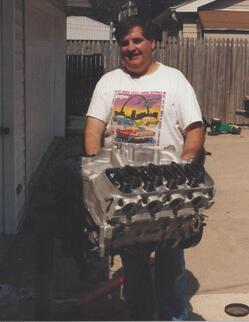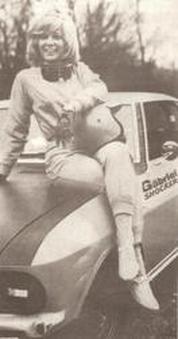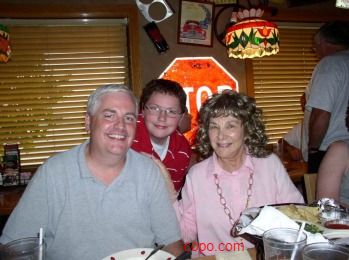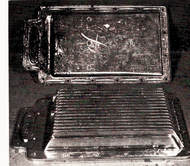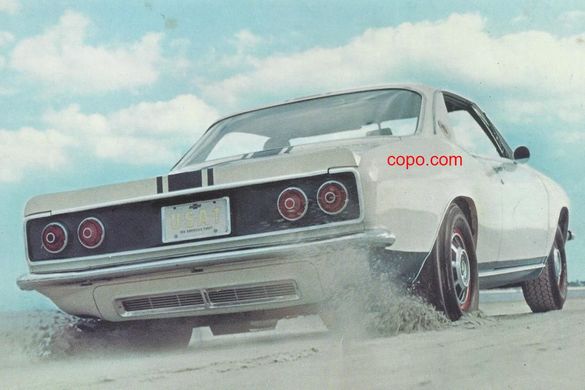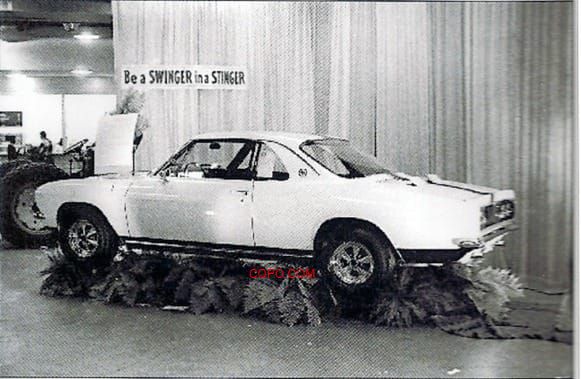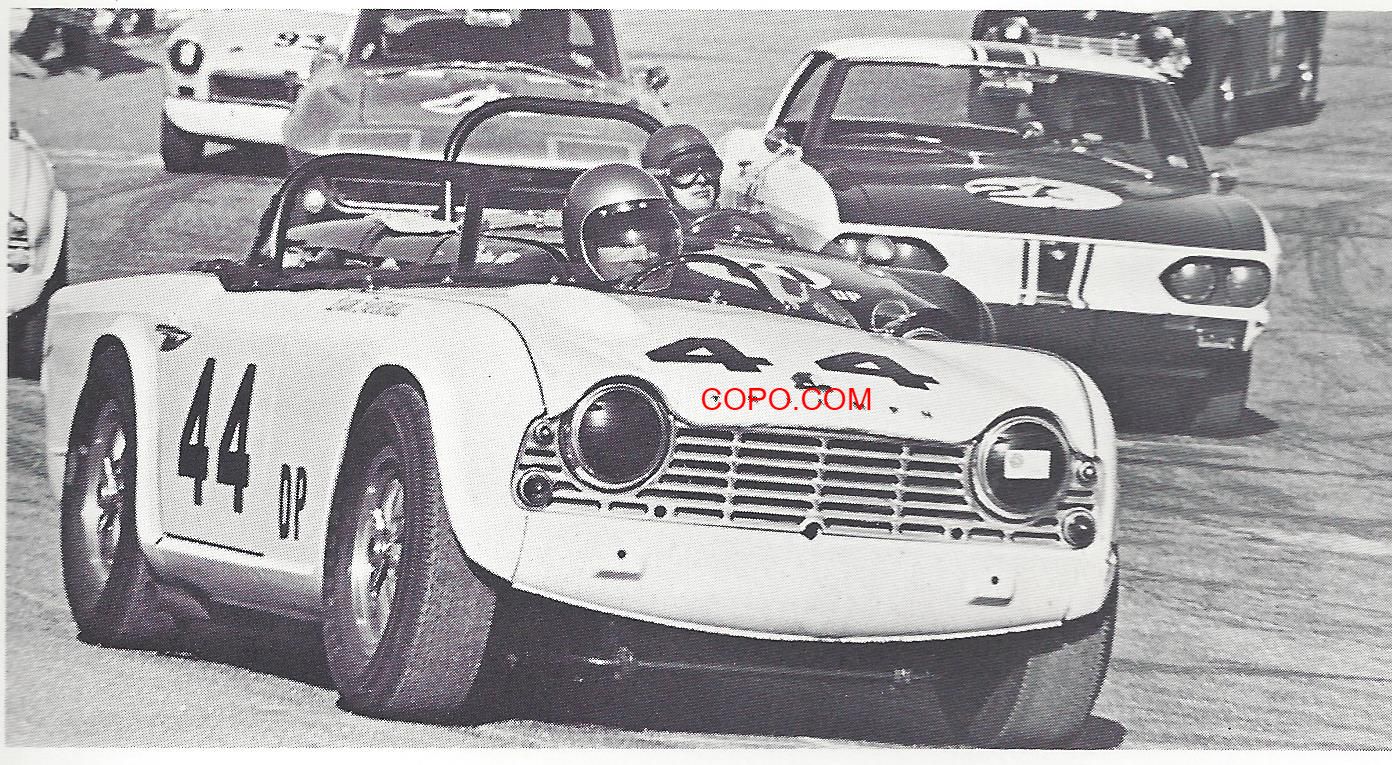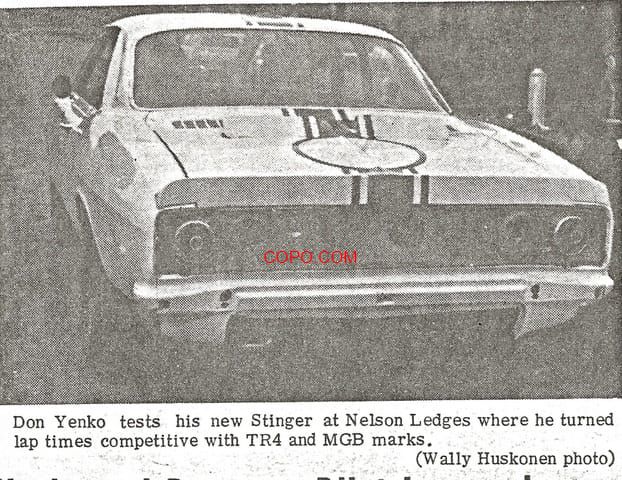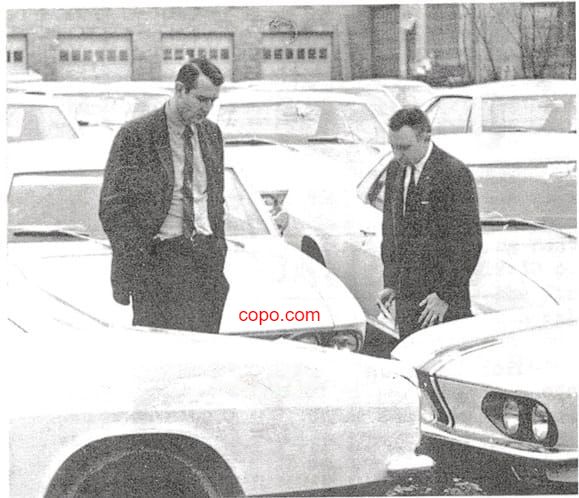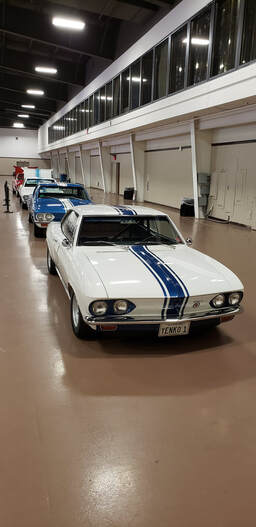
Mobile users: We are having problems with the menu pulldown. You may have to access a computer to launch all pages until this is resolved.
Welcome!
Our primary goal is to provide information on vehicles ordered by Don Yenko's dealership under the COPO process (Central Office Production Order), destined to become either Stinger Corvairs or Stinger Vegas.
1966 Yenko Stinger COPO Corvairs were ordered in Ermine White and in 1967 were in Marina Blue and Bolero Red. There was one White Stinger ordered in 1969.
Yenko Stinger Vegas were ordered and built in 1971 and 1972.
In 1972, the Stinger was also available as a Kammback.
2019 Corsa Convention
Chris Shade and I brought our Yenko Stinger Corvairs to the 2019 Convention at Pheasant Run in St. Charles, IL. They were displayed in the Mega Center (photo at right).
Welcome!
Our primary goal is to provide information on vehicles ordered by Don Yenko's dealership under the COPO process (Central Office Production Order), destined to become either Stinger Corvairs or Stinger Vegas.
1966 Yenko Stinger COPO Corvairs were ordered in Ermine White and in 1967 were in Marina Blue and Bolero Red. There was one White Stinger ordered in 1969.
Yenko Stinger Vegas were ordered and built in 1971 and 1972.
In 1972, the Stinger was also available as a Kammback.
2019 Corsa Convention
Chris Shade and I brought our Yenko Stinger Corvairs to the 2019 Convention at Pheasant Run in St. Charles, IL. They were displayed in the Mega Center (photo at right).
Yenko Stinger Archives is presented to you by Ed Cunneen
Special thanks to our contributors:
Bob Dunahugh, Raymond Behrends, James Rice, Rick Loving, Bill Hadley, Charlie Doerge, Kasey Vandenberg, Warren and Michael LeVeque, John Gray, Pat Chrisman, Chris Shade, and Rocco Egizio.
History of the Yenko Stinger Corvair
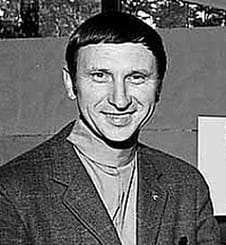
Don Yenko was a talented and gifted person. This site is dedicated to preserving the history he made in producing the Yenko Stingers.
CORVAIR STINGER HISTORY
In reviewing several Corvair Forums, it was noticed that the term "Yenko Stinger" is used quite loosely by some enthusiasts. With the influx of Clone's, Tributes, etc., entering the collector world, now might be a good time to review the site's definition of a Yenko Stinger.
Group 1 Vehicles ordered by Yenko through the Central Office (COPO's)
1966 Production YS-001 thru YS-101 and YS-105
Don Yenko requested a fleet order for one hundred 1966 Corsa Corvairs on October 28, 1965, requesting certain regular production options and also a request for special options not then available on Corvairs. This was one of the first uses of a COPO to order High Performance options. Yenko built a prototype Stinger (112945) prior to receiving the COPO order. There were two COPO Stingers that received Plates outside the one-hundred range: (YS-101 and YS-105).
1967 Production YS-107 thru YS-131
In December of 1966, Don followed up with a special COPO fleet order of twenty-five 1967 Monza Corvairs. Eleven Marina Blue and fourteen Bolero Red cars were ordered. We believe Yenko received all of these Monza's at his dealership, evidenced by the fact that 25 oil pans and 25 sets of Cyclone headers were ordered and delivered to the Yenko dealership between April and May, 1967.
All eleven of the 1967 Blue Stingers were produced and shipped through his Dealer network, and were given YS Plates 107-117. The YS-118-131 Plates had initially been reserved for the fourteen Red Stingers, but we can only account for shipment of YS-118, YS-119 and YS-120 through his US Dealer network.
We do not know the whereabouts of the remaining eleven red cars. It has been suggested that these cars were shipped to Canada without the YS Plates, as the ID's were not required for racing in Canada. We have yet to confirm this suggestion.
1969 Production YS-9700
There was only one 1969 COPO Corvair ordered and built by Yenko, which is referred to as the Goodyear Stinger.
Summary
So in Group 1, there are a total of one hundred and twenty-six Yenko Stingers ordered through the COPO program and sold by Yenko or distributed through his Network.
NOTE:
There were also three DANA Corvairs ordered through the COPO process and sold by Dana Chevrolet.
Group 2 Non-COPO Canadian Stingers YS-102 thru YS-104
Three Canadian Corsas were factory ordered in Canada without the COPO options, and sent to Canonsburg to be converted into Stingers. This ordering deviation, requiring the cars to be ordered in Canada instead of through Yenko, was due to the high Tariff costs associated with importing cars into Canada from the United States.
It is believed that YS-102 through YS-104 ID Plates were initially reserved for these cars, however, we do not know if all of the cars received these Plates. Stinger YS-104 did receive a Plate.
Group 3 Tagged Cars YS-132 and higher (with some exceptions)
NOTE: Several unused Plates from YS-121 through YS-131 may have been transferred to racers. These should not be considered COPO's.
We believe distribution of Serial Numbers (ID's) to racers, allowing them to compete in SCCA sanctioned events, started after the 1967 COPO Stinger production run ended.
Many were mailed out with Yenko kits or otherwise distributed.
This SCCA requirement requiring a YS Plate was abandoned in 1986, and having a Stinger serial number was no longer required.
UNUSED PLATE
YS-106 Plate was mailed to Jack Brenner, owner of YS-065, so that he could attempt to register the Stinger as a 1967 car. Illinois DMV did not agree, and required the car to be registered as a 1966. To date this Plate is still in the original envelope with the car and the YS-065 Plate remains attached to the car.
Conclusion
Just a note that a racer could legitimately move their serial number plate from one car to another.
So it's a bit of a different animal than the Group 1 and 2 cars, where value is usually ascertained by a Stinger containing the VIN, Fisher Body Plate, Serial number and Yenko options as built.
Keep in mind that one may locate a Stinger with an ID Plate in Group 1 or 2, but the original car built associated with that ID may no longer exist, or vice-versa. Feel free to contact this site for verification of the VIN and associated ID.
There may be considerable difference in the estimated the value of a Stinger, depending on which category it is in. Also take into consideration the overall condition, provenance, race history, and documentation the Stinger may have.
Disclaimer:
COPO.COM is not responsible for the accuracy of information on this site, since it has come from a variety of sources. Please conduct your own due diligence.
Group 1 Vehicles ordered by Yenko through the Central Office (COPO's)
1966 Production YS-001 thru YS-101 and YS-105
Don Yenko requested a fleet order for one hundred 1966 Corsa Corvairs on October 28, 1965, requesting certain regular production options and also a request for special options not then available on Corvairs. This was one of the first uses of a COPO to order High Performance options. Yenko built a prototype Stinger (112945) prior to receiving the COPO order. There were two COPO Stingers that received Plates outside the one-hundred range: (YS-101 and YS-105).
1967 Production YS-107 thru YS-131
In December of 1966, Don followed up with a special COPO fleet order of twenty-five 1967 Monza Corvairs. Eleven Marina Blue and fourteen Bolero Red cars were ordered. We believe Yenko received all of these Monza's at his dealership, evidenced by the fact that 25 oil pans and 25 sets of Cyclone headers were ordered and delivered to the Yenko dealership between April and May, 1967.
All eleven of the 1967 Blue Stingers were produced and shipped through his Dealer network, and were given YS Plates 107-117. The YS-118-131 Plates had initially been reserved for the fourteen Red Stingers, but we can only account for shipment of YS-118, YS-119 and YS-120 through his US Dealer network.
We do not know the whereabouts of the remaining eleven red cars. It has been suggested that these cars were shipped to Canada without the YS Plates, as the ID's were not required for racing in Canada. We have yet to confirm this suggestion.
1969 Production YS-9700
There was only one 1969 COPO Corvair ordered and built by Yenko, which is referred to as the Goodyear Stinger.
Summary
So in Group 1, there are a total of one hundred and twenty-six Yenko Stingers ordered through the COPO program and sold by Yenko or distributed through his Network.
NOTE:
There were also three DANA Corvairs ordered through the COPO process and sold by Dana Chevrolet.
Group 2 Non-COPO Canadian Stingers YS-102 thru YS-104
Three Canadian Corsas were factory ordered in Canada without the COPO options, and sent to Canonsburg to be converted into Stingers. This ordering deviation, requiring the cars to be ordered in Canada instead of through Yenko, was due to the high Tariff costs associated with importing cars into Canada from the United States.
It is believed that YS-102 through YS-104 ID Plates were initially reserved for these cars, however, we do not know if all of the cars received these Plates. Stinger YS-104 did receive a Plate.
Group 3 Tagged Cars YS-132 and higher (with some exceptions)
NOTE: Several unused Plates from YS-121 through YS-131 may have been transferred to racers. These should not be considered COPO's.
We believe distribution of Serial Numbers (ID's) to racers, allowing them to compete in SCCA sanctioned events, started after the 1967 COPO Stinger production run ended.
Many were mailed out with Yenko kits or otherwise distributed.
This SCCA requirement requiring a YS Plate was abandoned in 1986, and having a Stinger serial number was no longer required.
UNUSED PLATE
YS-106 Plate was mailed to Jack Brenner, owner of YS-065, so that he could attempt to register the Stinger as a 1967 car. Illinois DMV did not agree, and required the car to be registered as a 1966. To date this Plate is still in the original envelope with the car and the YS-065 Plate remains attached to the car.
Conclusion
Just a note that a racer could legitimately move their serial number plate from one car to another.
So it's a bit of a different animal than the Group 1 and 2 cars, where value is usually ascertained by a Stinger containing the VIN, Fisher Body Plate, Serial number and Yenko options as built.
Keep in mind that one may locate a Stinger with an ID Plate in Group 1 or 2, but the original car built associated with that ID may no longer exist, or vice-versa. Feel free to contact this site for verification of the VIN and associated ID.
There may be considerable difference in the estimated the value of a Stinger, depending on which category it is in. Also take into consideration the overall condition, provenance, race history, and documentation the Stinger may have.
Disclaimer:
COPO.COM is not responsible for the accuracy of information on this site, since it has come from a variety of sources. Please conduct your own due diligence.
November 12, 1965 Press Publication of Stinger
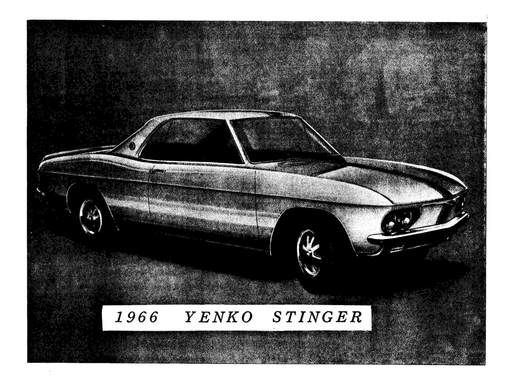
Fiberglass sail panel, composed of an inner and outer layer. This panel was used to give the coupe an appearance of a sports car with only two front seats. It was not a structural component.
The decal is embossed aluminum, with a black Stinger Bee.
The decal is embossed aluminum, with a black Stinger Bee.
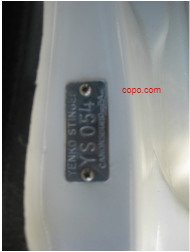
This is a picture of the Yenko Stinger Tag that was attached vertically to the driver's side A pillar (between the door hinges) by two screws.
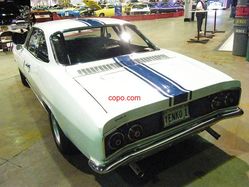
The fiberglass rear deck lid uses the factory hinges and latch. There are two flaps on the lid to aid in air flow. These are held open by magnets and metal supports. Note blue Tri-Stripes and tail pipes positioned through the rear grille panel.

COPO master Cylinder Brake Unit used. Cover originally was cadmium plated with a black hold down bracket. Cragar Finned Aluminum oil pan was used on the '66 Stingers (below).
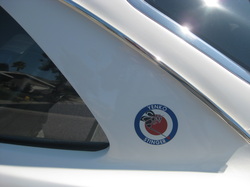
Fiberglass Landau Panels were added
BACKGROUND
During 1965, Don Yenko was having his share of problems. His Corvette was being outclassed by the lighter, Ford powered Shelby products. He needed Chevrolet to build a more competitive car. But after many discussions with the Corporate office, nothing was forthcoming. Don then decided, if Carol Shelby could produce his own race car, so could he!
Don chose to build his race car using the rear-engine Corvair, which had undergone a suspension upgrade in 1965. Chevrolet had initially approached the SCCA, but they said sorry, the Corvair is a sedan, not a sports car. Undaunted, Don suggested that by removing the back seat, and making improvements in the engine, brakes and suspension, he would "re-manufacture" the Corvairs into Sports Cars and call them Stingers.
SCCA tentatively agreed to Don's request, but indicated in manufacturing this sports car, there needed to be 100 cars produced. One hundred was SCCA's minimum production requirement. And further, if Yenko was to compete in the 1966 season, these cars had to be completed before the 1966 race season started!
It was toward the end of November, 1965 when Don got the approval from SCCA. He had only one month to purchase and modify 100 cars. However, he was so determined to have a winning season, 100 Ermine white Chevy Corvair Corsa's ended up in his back lot in mid December with Yenko Serial Numbers on them!
Yenko ordered these 100 Corsa's through the Central office, with the following options:
1966
10737 - Corsa 2D sport coupe
3900CC - Ermine white
3F41AA - special suspension equipment
3G81AA- positraction axle 3.55
3M20BB - 4 speed transmission
3N44AA - special steering equipment
3758DA - black vinyl trim
9513A - positraction axle 3.89 **
9681E - independent brake unit
** Only 50 of the cars were ordered with this COPO Option.
3G81AA was not included when 9513A was ordered.
The remaining 50 had RPO 3.55's.
The COPO 3.89 positraction differential was not available as an option for any other Corvair in 1966, but the gearset could be purchased over the counter at Chevrolet.
These 100 Corvairs were one of the first Chevrolet's to have a factory dual master Cylinder, and the Corvairs used the newly issued Cadillac unit in the order.
STINGER TREATMENT
Yenko's plan for the 1966 Stinger was to add fiberglass landau panels and a deck lid with an integral spoiler. Then he would remove all Corsa and Chevrolet emblems, filling the holes in with lead and plastic filler. These areas and parts were then repainted. To complete the exterior, a set of tri-stripes in blue would be added, along with 3 Stinger decals. There appears to be a variation in the color of blue paint used in production, from medium blue to a darker blue. This combination was recognized as the United States international racing colors.
On the inside, the back seat would be removed, replaced with a plywood board and carpet or a mat. Most interior emblems remained, but Yenko did have the Corsa emblem removed from the glove box, and replaced it with the embossed Yenko emblem. Optional gauges were installed at the customers request.
To dress up the engine compartment, headers were added, as well as a deep aluminum oil pan. This was finished off with new individual chrome air cleaners.
A number of the 100 COPO's never went through the entire conversion process. Jack Brenner, the original owner of YS-065, ordered his Stinger as a Stage II, but chose to add only the rear deck lid to his car. YS-022 received no exterior treatment, but the original owner also put his money toward a Stage II engine.
SCCA
An SCCA representative actually came out to Yenko's dealership to look at the cars. After he left, Don had to wait 9 days before getting confirmation that his application was accepted.
But the Yenko team was not overjoyed upon receiving the news. Evidently, SCCA decided that the Stingers should be placed in Class D Production, which was dominated four years in a row by a Triumph TR-4A. He felt that It would be nearly impossible to win in that class with a Stinger.
However, Don went to work on a Stage III 220 horsepower version, while at the same time, put out a substantial effort to sell the remaining Stingers. One thing Don had going for him was the fact that SCCA would only allow serial numbered Stingers to compete in their events. In other words, they had to buy Don's cars if they wanted to race in a sanctioned SCCA event.
Jerry Thompson was the driver for the first race of the season at Marlboro in January, 1966, and the Stinger came within one second of the current pacesetter, a TR4.
After this race, Don asked Jerry Thompson to compete for Yenko with the new Stinger, and Jerry went on to to win the Division Championship that year. However, he placed 5th in the Nationals. By 1967, Thompson had what it took to pull off the Divisional Championship and Class D National Championship, which was sealed at the Daytona ARRC.
Don joined forces with Moe Carter at Central Chevrolet in Canada for the Stinger program. Paperwork shows at least three Stingers at the dealership, including Mo Carter's race car.
1967
In December 1966, Don placed an order for 25 COPO 1967 Corvairs. These Monza's were built in February,1967, had an added feature: they came in both the alternate approved U.S. racing colors: (Marina) blue with white Stripes, and in the new Canadian Racing Colors: (Bolero) red with white stripes. It is believed that Don ordered the red cars because he had a firm commitment from City Chevrolet in Ontario.
As a background, the FIA had mandated use of specific racing colors in international racing until Spring of 1968, when owners were permited to paint their cars in the livery of their sponsors. Although this rule was not mandated for National SCCA race events, many owners continue this tradition.
Since the Corsa model had been discontinued at the end of the 1966 model year, these new 1967 cars were ordered in Monza trim.
There was also an additional problem. Chevrolet had discontinued the 140 HP option for model year 1967. Yenko was extremely upset. He needed this optional engine to be competitive. Well, by the time these Stingers were built, they did have COPO 140 engines, as a favor from Ed Cole.
1967 OPTIONS:
3900FF - Marina Blue (Bolero Red Code RR)
3F41AA - heavy duty suspension
3M20BC - four speed transmission
3N44AA - special steering
3758AA - black interior trim
9513A - 3:89 positraction differential
9551B - 140 special performance engine
9981A- wheel cover deletion
The new, simplified Monza dash lacked the Corsa tachometer and gauges. Don had requested a COPO for the Corsa dash, but it was rejected, so Don ordered Stewart-Warner 970-E tachometers and installed them in the center pods.
He also made available oil pressure and temperature gauges and an ammeter gauge for an additional $79.00. Dual master cylinders became a standard option for Corvairs in 1967.
In total, Chevrolet eventually built 232 COPO 9551B 140 engines equipped with manual transmissions, and 47 140's with Powerglides. However, many were sold over the counter, or used for warranties.
An interesting note is that the 1110330 distributor for the Yenko Stingers found with their original distributors have dates ranging from November to December of 1965. The distributors were most likely taken from over-stock, as the 140 RPO option had been discontinued in 1966.
1969
A very special Yenko Stinger (YS-9700) was made in 1969. It wasn't a Corsa or a Monza, but started out as a plain Jane model 500 coupe. It did not receive the classic rear window panels or fiberglass deck lid, or even the dark blue Tri-Stripes. But what it did receive was awesome! Yenko started out by installing a Stage IV engine, a special COPO for the 3.27:1 ring & pinion, S.C.C.A approved roll bar, heavy duty suspension, quick steering, and front and rear stabilizers. He then added a 24 gallon fuel tank, metallic sintered brakes, and front mounted oil cooler.
Goodyear Tire and Rubber Company had special ordered this car for some tire tests, and paid Yenko $5,021.65 for the privilege of taking ownership. Goodyear then welded steel scatter shields inside the wheel wells, an accessory gas tank, and went out to test tires.
BACKGROUND
During 1965, Don Yenko was having his share of problems. His Corvette was being outclassed by the lighter, Ford powered Shelby products. He needed Chevrolet to build a more competitive car. But after many discussions with the Corporate office, nothing was forthcoming. Don then decided, if Carol Shelby could produce his own race car, so could he!
Don chose to build his race car using the rear-engine Corvair, which had undergone a suspension upgrade in 1965. Chevrolet had initially approached the SCCA, but they said sorry, the Corvair is a sedan, not a sports car. Undaunted, Don suggested that by removing the back seat, and making improvements in the engine, brakes and suspension, he would "re-manufacture" the Corvairs into Sports Cars and call them Stingers.
SCCA tentatively agreed to Don's request, but indicated in manufacturing this sports car, there needed to be 100 cars produced. One hundred was SCCA's minimum production requirement. And further, if Yenko was to compete in the 1966 season, these cars had to be completed before the 1966 race season started!
It was toward the end of November, 1965 when Don got the approval from SCCA. He had only one month to purchase and modify 100 cars. However, he was so determined to have a winning season, 100 Ermine white Chevy Corvair Corsa's ended up in his back lot in mid December with Yenko Serial Numbers on them!
Yenko ordered these 100 Corsa's through the Central office, with the following options:
1966
10737 - Corsa 2D sport coupe
3900CC - Ermine white
3F41AA - special suspension equipment
3G81AA- positraction axle 3.55
3M20BB - 4 speed transmission
3N44AA - special steering equipment
3758DA - black vinyl trim
9513A - positraction axle 3.89 **
9681E - independent brake unit
** Only 50 of the cars were ordered with this COPO Option.
3G81AA was not included when 9513A was ordered.
The remaining 50 had RPO 3.55's.
The COPO 3.89 positraction differential was not available as an option for any other Corvair in 1966, but the gearset could be purchased over the counter at Chevrolet.
These 100 Corvairs were one of the first Chevrolet's to have a factory dual master Cylinder, and the Corvairs used the newly issued Cadillac unit in the order.
STINGER TREATMENT
Yenko's plan for the 1966 Stinger was to add fiberglass landau panels and a deck lid with an integral spoiler. Then he would remove all Corsa and Chevrolet emblems, filling the holes in with lead and plastic filler. These areas and parts were then repainted. To complete the exterior, a set of tri-stripes in blue would be added, along with 3 Stinger decals. There appears to be a variation in the color of blue paint used in production, from medium blue to a darker blue. This combination was recognized as the United States international racing colors.
On the inside, the back seat would be removed, replaced with a plywood board and carpet or a mat. Most interior emblems remained, but Yenko did have the Corsa emblem removed from the glove box, and replaced it with the embossed Yenko emblem. Optional gauges were installed at the customers request.
To dress up the engine compartment, headers were added, as well as a deep aluminum oil pan. This was finished off with new individual chrome air cleaners.
A number of the 100 COPO's never went through the entire conversion process. Jack Brenner, the original owner of YS-065, ordered his Stinger as a Stage II, but chose to add only the rear deck lid to his car. YS-022 received no exterior treatment, but the original owner also put his money toward a Stage II engine.
SCCA
An SCCA representative actually came out to Yenko's dealership to look at the cars. After he left, Don had to wait 9 days before getting confirmation that his application was accepted.
But the Yenko team was not overjoyed upon receiving the news. Evidently, SCCA decided that the Stingers should be placed in Class D Production, which was dominated four years in a row by a Triumph TR-4A. He felt that It would be nearly impossible to win in that class with a Stinger.
However, Don went to work on a Stage III 220 horsepower version, while at the same time, put out a substantial effort to sell the remaining Stingers. One thing Don had going for him was the fact that SCCA would only allow serial numbered Stingers to compete in their events. In other words, they had to buy Don's cars if they wanted to race in a sanctioned SCCA event.
Jerry Thompson was the driver for the first race of the season at Marlboro in January, 1966, and the Stinger came within one second of the current pacesetter, a TR4.
After this race, Don asked Jerry Thompson to compete for Yenko with the new Stinger, and Jerry went on to to win the Division Championship that year. However, he placed 5th in the Nationals. By 1967, Thompson had what it took to pull off the Divisional Championship and Class D National Championship, which was sealed at the Daytona ARRC.
Don joined forces with Moe Carter at Central Chevrolet in Canada for the Stinger program. Paperwork shows at least three Stingers at the dealership, including Mo Carter's race car.
1967
In December 1966, Don placed an order for 25 COPO 1967 Corvairs. These Monza's were built in February,1967, had an added feature: they came in both the alternate approved U.S. racing colors: (Marina) blue with white Stripes, and in the new Canadian Racing Colors: (Bolero) red with white stripes. It is believed that Don ordered the red cars because he had a firm commitment from City Chevrolet in Ontario.
As a background, the FIA had mandated use of specific racing colors in international racing until Spring of 1968, when owners were permited to paint their cars in the livery of their sponsors. Although this rule was not mandated for National SCCA race events, many owners continue this tradition.
Since the Corsa model had been discontinued at the end of the 1966 model year, these new 1967 cars were ordered in Monza trim.
There was also an additional problem. Chevrolet had discontinued the 140 HP option for model year 1967. Yenko was extremely upset. He needed this optional engine to be competitive. Well, by the time these Stingers were built, they did have COPO 140 engines, as a favor from Ed Cole.
1967 OPTIONS:
3900FF - Marina Blue (Bolero Red Code RR)
3F41AA - heavy duty suspension
3M20BC - four speed transmission
3N44AA - special steering
3758AA - black interior trim
9513A - 3:89 positraction differential
9551B - 140 special performance engine
9981A- wheel cover deletion
The new, simplified Monza dash lacked the Corsa tachometer and gauges. Don had requested a COPO for the Corsa dash, but it was rejected, so Don ordered Stewart-Warner 970-E tachometers and installed them in the center pods.
He also made available oil pressure and temperature gauges and an ammeter gauge for an additional $79.00. Dual master cylinders became a standard option for Corvairs in 1967.
In total, Chevrolet eventually built 232 COPO 9551B 140 engines equipped with manual transmissions, and 47 140's with Powerglides. However, many were sold over the counter, or used for warranties.
An interesting note is that the 1110330 distributor for the Yenko Stingers found with their original distributors have dates ranging from November to December of 1965. The distributors were most likely taken from over-stock, as the 140 RPO option had been discontinued in 1966.
1969
A very special Yenko Stinger (YS-9700) was made in 1969. It wasn't a Corsa or a Monza, but started out as a plain Jane model 500 coupe. It did not receive the classic rear window panels or fiberglass deck lid, or even the dark blue Tri-Stripes. But what it did receive was awesome! Yenko started out by installing a Stage IV engine, a special COPO for the 3.27:1 ring & pinion, S.C.C.A approved roll bar, heavy duty suspension, quick steering, and front and rear stabilizers. He then added a 24 gallon fuel tank, metallic sintered brakes, and front mounted oil cooler.
Goodyear Tire and Rubber Company had special ordered this car for some tire tests, and paid Yenko $5,021.65 for the privilege of taking ownership. Goodyear then welded steel scatter shields inside the wheel wells, an accessory gas tank, and went out to test tires.
STINGER WARRANTY
Stage I Stingers came with the standard Chevrolet warranty. Stages II and up carried a 90 day/4000 mile parts warranty on the drive train and the standard warranty on the rest of the car.
Intellectual and industrial copyright related to the Site
In accessing the COPO.com (Sites), Users are granted a restricted license of use thereof. This license grants Users a restricted and non-exclusive entitlement of use for private purposes only with regard the Site's content. In this respect, Users are granted only the right to display the site on a single-station screen. Pursuant to laws governing the rights of literary and artistic property (copyright) or related rights, the display and/or reproduction of all or a part of Site components are strictly prohibited outside the aforementioned stipulations. In this respect, subject to the rights granted by the present directions and in the absence of formal, written and prior authorization from COPO.COM, any reproduction, copying, change and/or exploitation together with any usage of all or a part of Site content on any medium whatsoever, for whatever reason and in whatever form, is strictly prohibited. Any request for authorization should be requested in the Contact Us section. Any unauthorized use shall constitute an infringement of copyright punishable by applicable laws. Furthermore, all the brands mentioned on the Site are trademarks and as such are protected. No use of any one of these trademarks may be made without the prior, express and written consent of COPO.COM, under pain of infringement of copyright. Moreover, no hypertext link to the Site and/or the pages contained therein may be made by the User on his or her own site without the express and written agreement of COPO.COM. Any request for such authorization should be forwarded using the Contact Us section.
In accessing the COPO.com (Sites), Users are granted a restricted license of use thereof. This license grants Users a restricted and non-exclusive entitlement of use for private purposes only with regard the Site's content. In this respect, Users are granted only the right to display the site on a single-station screen. Pursuant to laws governing the rights of literary and artistic property (copyright) or related rights, the display and/or reproduction of all or a part of Site components are strictly prohibited outside the aforementioned stipulations. In this respect, subject to the rights granted by the present directions and in the absence of formal, written and prior authorization from COPO.COM, any reproduction, copying, change and/or exploitation together with any usage of all or a part of Site content on any medium whatsoever, for whatever reason and in whatever form, is strictly prohibited. Any request for authorization should be requested in the Contact Us section. Any unauthorized use shall constitute an infringement of copyright punishable by applicable laws. Furthermore, all the brands mentioned on the Site are trademarks and as such are protected. No use of any one of these trademarks may be made without the prior, express and written consent of COPO.COM, under pain of infringement of copyright. Moreover, no hypertext link to the Site and/or the pages contained therein may be made by the User on his or her own site without the express and written agreement of COPO.COM. Any request for such authorization should be forwarded using the Contact Us section.
Contact Us
Contact Ed Cunneen at: reply@copo.com for information on this site.

Ted Cunneen with Donna Mae after receiving First Place "THINK PINK" award with YS-107
PROTOTYPE TO PRODUCTION
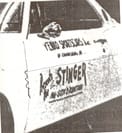
THE BEGINNING
On September 26, 1965, Sterling Moss drove a Yenko-modified version of the yet to be named Stinger at the Upper Marlboro, Maryland race course.
His candid, but promising review of the Yenko-modified 1965 Corsa set the stage for the marque.
On November 7, 1965, Yenko was ready for a press day. He had taken a new 1966 Corsa from his lot, Stingerized it, and took it to Nelson Ledges. Don also paid for Jerry Thompson to bring down his "Serious Business" A-sedan, a 1965 Corvair 500, which was a real race car. Of course the Racer ate the new Corsa alive, as the Prototype was more show than go at that time.
On September 26, 1965, Sterling Moss drove a Yenko-modified version of the yet to be named Stinger at the Upper Marlboro, Maryland race course.
His candid, but promising review of the Yenko-modified 1965 Corsa set the stage for the marque.
On November 7, 1965, Yenko was ready for a press day. He had taken a new 1966 Corsa from his lot, Stingerized it, and took it to Nelson Ledges. Don also paid for Jerry Thompson to bring down his "Serious Business" A-sedan, a 1965 Corvair 500, which was a real race car. Of course the Racer ate the new Corsa alive, as the Prototype was more show than go at that time.
Stinger Prototype built prior to the 100 Corsa COPO run on display at Yenko Dealership
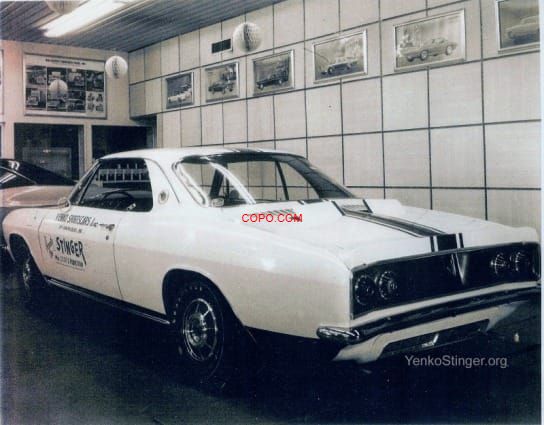
This is a picture of the Yenko Prototype displayed in the Yenko Dealership showroom. It it is the same car that was displayed November 28, 1965 during the Daytona ARRC runoffs-See Below). Note the larger Stinger Decal on the landau panel and tail pipes under rear valance panel. Sign said: Yenko Sportscars, Inc. - of Canonsburg, PA - Presents the Stinger - 1966 SCCA "D" Production.
Prototype Stinger on display at the Daytona run-offs during November 27 & 28, 1965 event
(Photo Courtesy of Corvair Communique)
ALCOA DISPLAY
The newspaper clipping below shows the Stinger on display at the Alcoa Building on Wednesday, Thursday, and Friday, December 8-10, 1965. Reference: Pittsburgh Post Gazette. This was exactly the time that the first batch of the one hundred white Corsa's arrived at the Yenko dealership. I believe this car was the Prototype Stinger.
Shipment of the 100 COPO Corsa's
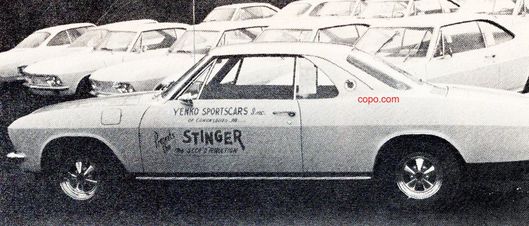
Notice Factory window sticker in quarter window of the Stinger in front. I believe this is the first completed production Stinger, getting ready for the Pittsburgh Auto Show. Notice the larger Stinger decal is still used, as the new emblems were not delivered until January 6th. Also notice Chrome Wheels.
Picture courtesy of Complete Book of Engines No. 2. (1966)
Picture courtesy of Complete Book of Engines No. 2. (1966)
First production Stinger (above) at the Pittsburgh auto show on January 12, 1966. Shows chrome wheels and Tailpipes through rear panel. Also has the new Yenko Window Sticker attached to quarter window. Talbot side view mirrors complete the exterior package. This car may have the new Stinger decals which had just arrived.
Jerry Thompson driving YS-005 (22) at first SCCA race during January 6- 9 event.
Don Yenko and Donna Mae drove YS-085 during testing (below).
Photo courtesy of Corvair Communique.

Don Yenko behind the wheel of YS-085 at Nelson Ledges January 6, 1966. Notice no Bee emblems or numbers yet. Notice tachometer mounted on dash.
Picture courtesy of Complete Book of Engines No. 2. (1966)
Picture courtesy of Complete Book of Engines No. 2. (1966)
On January 6, 1966 Yenko took two of his new Stingers to Nelson Ledges for testing. They sported the new RST engines. One of these cars we believe would eventually end up being Dick Thompson's YS-085 Stinger. The other was Jerry Thompson's YS-005.
Overall, the Stinger racked up a new unofficial Dp record of 57.0 seconds at the track.
On January 9, 1966, for the first SCCA race of the season, Don asked Donna Mae to drive one Stinger at Marlboro, and for Jerry Thompson to drive the other. YS-085 was piloted to a lap time of 1:38.5, only a second off Bob Tullius' TR4, before breaking a clutch just before the feature race.
Jerry piloted his Stinger YS-005 to a third place finish behind Tullis and Stockton in TR-4's. Not bad for a first outing! By this date, twenty Stingers had already been sold.
Thompson raced the YS-005 Stinger for the remainder of the year, and again in 1967. Ultimately, Jerry received the car as a gift after the 1967 successful season, where he won the SCCA National Championship in "D" production.
Overall, the Stinger racked up a new unofficial Dp record of 57.0 seconds at the track.
On January 9, 1966, for the first SCCA race of the season, Don asked Donna Mae to drive one Stinger at Marlboro, and for Jerry Thompson to drive the other. YS-085 was piloted to a lap time of 1:38.5, only a second off Bob Tullius' TR4, before breaking a clutch just before the feature race.
Jerry piloted his Stinger YS-005 to a third place finish behind Tullis and Stockton in TR-4's. Not bad for a first outing! By this date, twenty Stingers had already been sold.
Thompson raced the YS-005 Stinger for the remainder of the year, and again in 1967. Ultimately, Jerry received the car as a gift after the 1967 successful season, where he won the SCCA National Championship in "D" production.
